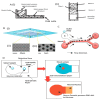Potential Point-of-Care Microfluidic Devices to Diagnose Iron Deficiency Anemia
- PMID: 30103424
- PMCID: PMC6111990
- DOI: 10.3390/s18082625
Potential Point-of-Care Microfluidic Devices to Diagnose Iron Deficiency Anemia
Abstract
Over the past 20 years, rapid technological advancement in the field of microfluidics has produced a wide array of microfluidic point-of-care (POC) diagnostic devices for the healthcare industry. However, potential microfluidic applications in the field of nutrition, specifically to diagnose iron deficiency anemia (IDA) detection, remain scarce. Iron deficiency anemia is the most common form of anemia, which affects billions of people globally, especially the elderly, women, and children. This review comprehensively analyzes the current diagnosis technologies that address anemia-related IDA-POC microfluidic devices in the future. This review briefly highlights various microfluidics devices that have the potential to detect IDA and discusses some commercially available devices for blood plasma separation mechanisms. Reagent deposition and integration into microfluidic devices are also explored. Finally, we discuss the challenges of insights into potential portable microfluidic systems, especially for remote IDA detection.
Keywords: all-in-one; iron deficiency anemia; microfluidic; point-of-care.
Conflict of interest statement
The authors declare no conflicts of interest.
Figures






Similar articles
-
Microfluidic Point-of-Care (POC) Devices in Early Diagnosis: A Review of Opportunities and Challenges.Sensors (Basel). 2022 Feb 18;22(4):1620. doi: 10.3390/s22041620. Sensors (Basel). 2022. PMID: 35214519 Free PMC article. Review.
-
Non-invasive iron deficiency diagnosis: a saliva-based approach using capillary flow microfluidics.Anal Methods. 2024 Apr 25;16(16):2489-2495. doi: 10.1039/d3ay01933k. Anal Methods. 2024. PMID: 38502566
-
Paper based microfluidics: A forecast toward the most affordable and rapid point-of-care devices.Prog Mol Biol Transl Sci. 2022;186(1):109-158. doi: 10.1016/bs.pmbts.2021.07.010. Epub 2021 Aug 19. Prog Mol Biol Transl Sci. 2022. PMID: 35033281
-
Microfluidic Gastrointestinal Cell Culture Technologies-Improvements in the Past Decade.Biosensors (Basel). 2024 Sep 19;14(9):449. doi: 10.3390/bios14090449. Biosensors (Basel). 2024. PMID: 39329824 Free PMC article. Review.
-
Microfluidic Point-of-Care Diagnostics for Multi-Disease Detection Using Optical Techniques: A Review.IEEE Trans Nanobioscience. 2024 Jan;23(1):140-147. doi: 10.1109/TNB.2023.3291544. Epub 2024 Jan 3. IEEE Trans Nanobioscience. 2024. PMID: 37399163 Review.
Cited by
-
Efficient and Simple Paper-Based Assay for Plasma Separation Using Universal Anti-H Agglutinating Antibody.ACS Omega. 2022 Oct 28;7(44):40109-40115. doi: 10.1021/acsomega.2c04908. eCollection 2022 Nov 8. ACS Omega. 2022. PMID: 36385881 Free PMC article.
-
Microfluidic system for screening disease based on physical properties of blood.Bioimpacts. 2020;10(3):141-150. doi: 10.34172/bi.2020.18. Epub 2019 May 22. Bioimpacts. 2020. PMID: 32793436 Free PMC article.
-
Anemia Diagnostic System Based on Impedance Measurement of Red Blood Cells.Sensors (Basel). 2021 Dec 1;21(23):8043. doi: 10.3390/s21238043. Sensors (Basel). 2021. PMID: 34884044 Free PMC article.
-
Emerging point-of-care technologies for anemia detection.Lab Chip. 2021 May 18;21(10):1843-1865. doi: 10.1039/d0lc01235a. Lab Chip. 2021. PMID: 33881041 Free PMC article. Review.
-
Point-of-care technologies in heart, lung, blood and sleep disorders from the Center for Advancing Point-of-Care Technologies.Curr Opin Biomed Eng. 2019 Sep;11:58-67. doi: 10.1016/j.cobme.2019.08.011. Epub 2019 Sep 21. Curr Opin Biomed Eng. 2019. PMID: 32582870 Free PMC article.
References
-
- World Health Organization . The Global Prevalence of Anaemia in 2011. WHO; Geneva, Switzerland: 2011.
-
- Berger J., Dillon J.-C. Control of iron deficiency in developing countries. Sante. 2002;12:22–30. - PubMed
-
- Sukrat B., Sirichotiyakul S. The prevalence and causes of anemia during pregnancy in Maharaj Nakorn Chiang Mai Hospital. J. Med. Assoc. Thai. 2006;89(Suppl 4):S142–S146. - PubMed
Publication types
MeSH terms
LinkOut - more resources
Full Text Sources
Other Literature Sources
Miscellaneous

